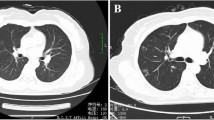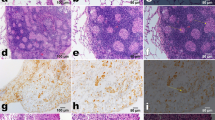Abstract
Purpose
The degree of silicosis exposure is closely related to the progress of silicosis. At present, we use animal and human studies to explore whether silicon can be an important exposure marker in the development of silicosis.
Methods
Rats were randomly divided into 2 groups: (1) controls; and (2) silicosis. Rats in the silicosis group were killed at 4, 8, 12, 16, 24 h, 3, 7, 14, 21, and 28 days. Hematoxylin–eosin (HE) and immunohistochemistry (IHC) were performed to observe the histomorphology of lung tissue. The expression levels of CC16 and SP-D were detected using ELISA kits. In addition, we conducted a population study. Workers who have been selected to work in an iron mine for more than 1 year as research objects. The population was divided into four groups: silicosis exposure group (workers exposed to silica dust for more than 1 year in an iron mine were selected); patients group (silicosis patients); observation group (evidence of disease not meeting formal diagnostic criteria) and control group. Both the levels of trace silicon in the urine and blood of rats and human subjects were measured with ICP-MS.
Results
Serum levels of silicon were immediately increased in rats exposed to silicon dust. Similarly, our population study revealed that the silicon level in the silica exposure group and the observing group (exposed but no obvious symptoms) were significantly increased over that of the control group (P < 0.05). In subjects with extended exposure to silica, the serum and urine silicon level in exposed workers appeared to rapidly increase, reaching its peak in 1–5 years, followed by a gradual decline thereafter. Workers exposed to dust for less than 10 years were divided into subgroups by 2-year limit. The levels of serum silicon, urine silicon, TGF-β1, and TNF-α were significantly higher than that of control group.
Conclusion
Changes of the serum levels of silicon occurred earlier than the expression of cytokines such as TNF-α, TGF-β1, CC16, and SP-D. The level of silicon in workers rapidly increased after exposure to silica, and the change occurred before the expression of TGF-β1 and TNF-α. As a whole, the findings suggest that determining the level of silicon in vivo might be an effective exposure marker in the diagnosis and pathogenesis of silicosis.








Similar content being viewed by others
Abbreviations
- ICP-MS:
-
Inductively coupled plasma mass spectrometry
- TNF-α:
-
Tumor necrosis factor alpha
- TGF-β1:
-
Transforming growth factor-beta
- CC16:
-
Clara cell protein 16
- SP-D:
-
Surfactant protein D
- BALF:
-
Bronchoalveolar lavage fluid
References
American Thoracic Society (1997) Adverse effects of crystalline silica exposure. Am J Respir Crit Care Med 155(2):761–765
Banks LDE, Houston FS, Jindal SK (2015) Can we alter the natural history of silicosis? Chest 148(3):574–576
Biagioni BJ, Tam S, Chen YW et al (2016) Effect of controlled human exposure to diesel exhaust and allergen on airway surfactantprotein D, myeloperoxidase and club (Clara) cell secretory protein 16. Clin Exp Allergy 46(9):1206–1213
Braz NF, Cameiro AP, Amorim MR et al (2014) Association between inflammatory biomarkers in plasma, radiological severity, and duration of exposure in patients with silicosis. J Occup Environ Med 56(5):493–497
Chen CM, Chou HC, Hsu HH et al (2005) Transforming growth factor-beta l up regulation is independent of angiotensin in paraquat-induced lung fibrosis. Toxicology 216(2–3):181–187
Doubková M, Karpíšek M, Mazoch J et al (2016) Prognostic significance of surfactant protein A, surfactant protein D, Clara cell protein16, S100 protein, trefoil factor 3, and prostatic secretory protein 94 in idiopathic pulmonary fibrosis, sarcoidosis, and chronic pulmonary obstructive disease. Sarcoidosis Vasc Diffuse Lung Dis 33(3):224–234
Fernández Álvarez R, Martínez González C, Quero Martínez A et al (2015) Guidelines for the diagnosis and monitoring of silicosis. Arch Bronconeumol 51(2):86–93
Gulumian M, Borm PJ, Vallyathan V et al (2006) Mechanistically identified suitable biomarkers of exposure, effect, and susceptibility forsilicosis and coal-worker’s pneumoconiosis: a comprehensive review. J Toxicol Environ Health B Crit Rev 9(5):357–395
Hoy RF, Brims F (2017) Occupational lung diseases in Australia. Med J Aust 207(10):443–448
Jiang PR, Cao Z, Qiu ZL et al (2015) Plasma levels of TNF-α and MMP-9 in patients with silicosis. Eur Rev Med Pharmacol Sci 19(9):1716–1720
Kawasaki H (2015) A mechanistic review of silica-induced inhalation toxicity. Inhal Toxicol 27(8):363–377
Ke Q, Li J, Ding J et al (2006) Essential role of ROS-mediated NFAT activation in TNF-α induction by crystalline silica exposure. Am J Physiol Lung Cell Mol Physiol 291(2):L257–L264
Krzciuk K (2016) Intelligent analysis of samples by semiquantitative inductively coupled plasma-mass spectrometry (ICP-MS) technique: a review. Crit Rev Anal Chem 46(4):284–290
Kui W (1996) Trace elements in the life science, 2nd edn. China metrology press, Beijing, pp 143–150
Laney AS, Petsonk EL, Hale JM et al (2012) Potential determinants of coal workers’ pneumoconiosis, advanced pneumoconiosis, and progressive massive fibrosis among underground coal miners in the United States, 2005–2009. Am J Public Health 102(Suppl 2):S279–S283
Leung CC, Yu IT, Chen W (2012) Silicosis. Lancet 379(9830):2008–2018
Li X, Hu Y, Jin Z et al (2009) Silica-induced TNF-alpha and TGF-beta1 expression in RAW264.7 cells are dependent on Src-ERK/AP-1 pathways. Toxicol Mech Methods 19(1):51–58
Listed N (1988) Diseases associated with exposure to silica and nonfibrous silicate minerals. Arch Pathol Lab Med 112(7):673–720
Mittal M, Kumar K, Anghore D, Rawal RK (2017) ICP-MS: analytical method for identification and detection of elemental impurities. Curr Drug Discov Technol 14(2):106–120
Nardi J, Nascimento S, Göethel G et al (2018) Inflammatory and oxidative stress parameters as potential early biomarkers for silicosis. Clin Chim Acta 484:305–313
Nelson G, Girdler-Brown B, Ndlovu N et al (2010) Three decades of silicosis: disease trends at autopsy in South African gold miners. Environ Health Perspect 118(3):421–426
Pandey JK, Agarwal D (2012) Biomarkers: a potential prognostic tool for silicosis. Indian J Occup Environ Med 16(3):101–107
Pollard KM (2016) Silica, silicosis, and autoimmunity. Front Immunol 7:97
Porter DW, Hubbs AF, Mercer R et al (2004) Progression of lung inflammation and damage in rats after cessation of silica inhalation. Toxicol Sci 79(2):370–380
Sunil VR, Vayas KN, Cervelli JA et al (2018) Protective role of surfactant protein-D against lung injury and oxidative stress induced by nitrogen mustard. Toxicol Sci Novl 166(1):108–122
Tiwari RR (2005) Biomarkers of silicosis: potential candidates. Ind J Occup Environ Med 9(3):103–106
Verma DK, Rajhans GS, Malik OP et al (2014) Respirable dust and respirable silica exposure in Ontario gold mines. J Occup Environ Hyg 11(2):111–116
Wang SX, Liu P, Wei MT et al (2007) Roles of serum clara cell protein 16 and surfactant protein-D in the early diagnosis and progression of silicosis. J Occup Environ Med 49(8):834–839
Wang Z, Wang C, Liu S et al (2017) Specifically formed corona on silica nanoparticles enhances transforming growth factor β1 activity in triggering lung fibrosis. ACS Nano 11(2):1659–1672
Wong AP, Keating A, Waddell TK (2009) Airway regeneration: the role of the Clara cell secretory protein and the cells that express it. Cytotherapy 11(6):676–687
Wutzler S, Backhaus L, Henrich D et al (2012) Clara cell protein 16: a biomarker for detecting secondary respiratory complications in patients with multiple injuries. J Trauma Acute Care Surg 73(4):838–842
Zhao JY, Wang SJ (2016) Pneumoconiosis should be curable. J Environ Occup Med 33(1):90–95
Acknowledgements
Prof. Darrell Brann (Department of Neuroscience and Regenerative Medicine, Medical College of Georgia, Augusta University, Augusta, Georgia 30912, USA) helped write and critically reviewed the manuscript and provided intellectual input.
Funding
The work was supported by the National Natural Science Foundation of China (No. 81673119 and No. 81602814), Hebei Province Natural Science Foundation of China (No. H2018209337) and Hebei Provincial Key Research and Development Projects in (No. 192777129D) and Science and Technology Research Project of Colleges and Universities in Hebei Province (No. ZD2016026). The funders had no role in study design, data collection and analysis, decision to publish, or preparation of the manuscript.
Author information
Authors and Affiliations
Contributions
HW and XH designed the study. JC, LG and RW carried out the experimental work, analyzed the data, and drafted the manuscript. HL participated in the design of the study and critically reviewed the manuscript and provided intellectual input. JZ conceived the study, and participated in coordination, and helped in drafting the manuscript. All authors read and approved the final manuscript.
Corresponding author
Ethics declarations
Conflict of interest
The authors declare that they have no competing interests.
Ethics approval and consent to participate
This study was approved by the Human Research Ethics Committee of North China University of Science and Technology (Clearance number 2012014). The research objectives and methodology were explained to the subjects and written informed consent was signed by each participant.
Consent for publication
All the authors declare that they are consent for the publication.
Additional information
Publisher's Note
Springer Nature remains neutral with regard to jurisdictional claims in published maps and institutional affiliations.
Rights and permissions
About this article
Cite this article
Wang, H., Cui, J., Hao, X. et al. Silicon, an important exposure marker in vivo in silicosis research. Int Arch Occup Environ Health 94, 1513–1522 (2021). https://doi.org/10.1007/s00420-021-01729-4
Received:
Accepted:
Published:
Issue Date:
DOI: https://doi.org/10.1007/s00420-021-01729-4




